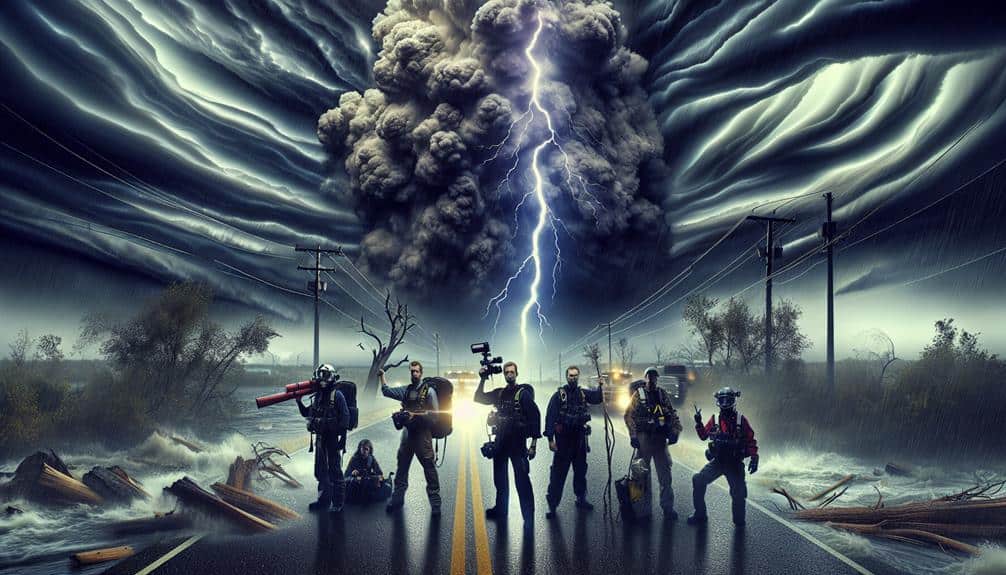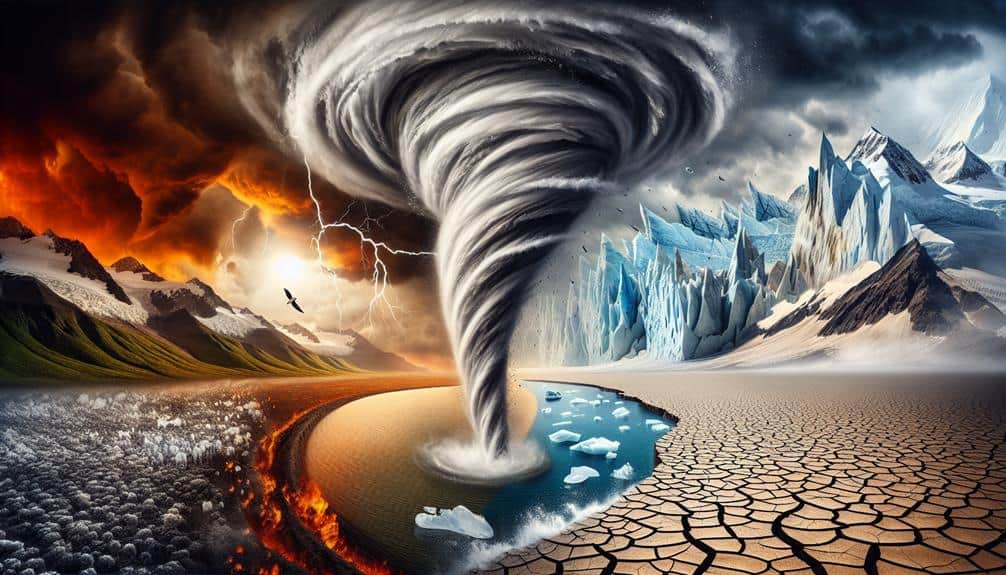As climate change accelerates, we see more frequent and severe storms, with a 15% increase in occurrences over the past two decades. These changes bring more opportunities for storm chasers to document weather events but also pose greater risks. We need advanced forecasting tools, better protective gear, and updated safety protocols to mitigate hazards like high winds and flooding. Altered storm patterns require us to enhance data collection and adapt to new hotspots of activity. Additionally, the economic impact is significant, with rising costs and new revenue streams from media and research. By understanding these shifts, we can better prepare for future challenges.
Key Points
- Increased storm frequency and severity provide more research opportunities but heighten risks for storm chasers.
- Shifting storm patterns necessitate enhanced data collection and updated geographical focus for accurate forecasting.
- Intensified weather events demand more robust safety protocols and advanced risk management strategies.
- Advanced forecasting techniques and technology improve storm prediction but require continuous monitoring and cutting-edge equipment.
Increased Storm Frequency
As climate change accelerates, we're observing a noticeable uptick in the frequency of severe storm events. Data from the National Oceanic and Atmospheric Administration (NOAA) reveals a 15% increase in storm occurrences over the past two decades. This escalation presents both opportunities and challenges for storm chasers. On one hand, the increased frequency means more opportunities to study and document these powerful natural phenomena. On the other hand, this uptick also intensifies chasing challenges, requiring more advanced forecasting tools and safety measures.
The environmental impacts of this trend are significant. Increased storm frequency exacerbates soil erosion, disrupts local ecosystems, and strains emergency response systems. For storm chasers, understanding these environmental impacts is essential not only for personal safety but also for contributing valuable data to climate science. By documenting storms and their aftermaths, we help paint a clearer picture of how climate change is reshaping our world.
However, these pursuits come with inherent risks. More frequent storms mean more chances of encountering hazardous conditions. As we navigate these challenges, our commitment to advancing scientific knowledge while ensuring our safety remains crucial. This delicate balance highlights the evolving nature of storm chasing in a changing climate.
Intensified Storm Severity
Intensified storm severity, driven by climate change, demands our attention as data shows a marked increase in the strength and destructiveness of these events. We can't overlook the implications for storm chasers. The necessity for advanced risk management and stringent safety measures has never been more crucial. Stronger storms mean greater hazards—not just from high winds and flooding, but also from debris and infrastructure collapse.
For us, it's crucial to adapt our strategies. Investing in better protective gear, reliable communication devices, and advanced forecasting tools becomes essential. The environmental impact of these intensified storms is profound, offering us numerous research opportunities to understand and mitigate the damage. Our role in documenting and studying these phenomena is crucial for developing new safety protocols and improving existing ones.
We must remain vigilant and analytical, continuously updating our approaches based on the latest data. This ensures not only our safety but also the accuracy and reliability of our contributions to climate science. As storm chasers dedicated to our craft, we've a responsibility to adapt and evolve, making sure that our pursuit of freedom and adventure doesn't come at an unacceptable risk.
Changing Storm Patterns
We've observed that climate change is leading to increased storm intensity, altered storm frequencies, and shifting storm locations.
Data shows that storms are becoming more powerful and occurring in areas that previously had lower storm activity.
This means we need to adjust our storm chasing strategies to account for these changing patterns.
Increased Storm Intensity
Climate change is leading to more frequent and intense storms, fundamentally altering the patterns storm chasers have historically relied upon. With increased storm intensity, our chasing strategies must adapt to these evolving conditions. Enhanced storm strength means we must prioritize safety precautions more than ever. The unpredictability of these powerful systems calls for advanced planning and real-time adjustments. We need to invest in state-of-the-art technology to track storms accurately and guarantee our safety while collecting valuable data.
From a research standpoint, the heightened intensity of storms presents unprecedented opportunities for data collection. These conditions allow us to study the dynamics of severe weather in ways previously unimaginable. Advanced instrumentation and high-resolution models enable us to capture detailed information on storm structure, behavior, and evolution.
As storm chasers, we're at the forefront of this critical research, contributing to a broader understanding of how climate change impacts storm systems.
Indeed, while these changes pose significant challenges, they also open new avenues for scientific discovery. By refining our chasing strategies and maintaining rigorous safety precautions, we can maximize the research opportunities presented by increased storm intensity, making meaningful contributions to meteorological science.
Altered Storm Frequencies
The shifting frequencies of storm occurrences necessitate a reevaluation of our predictive models and chasing schedules. As climate change alters storm patterns, we've observed increased variability in the frequency and intensity of these events. This variability creates both challenges and research opportunities.
Accurate forecasting is now more critical than ever, and our current models must adapt to incorporate this new data. We need to enhance our data collection methods to improve forecasting accuracy. By integrating more real-time data, we can refine our predictions and better prepare for these altered storm frequencies.
Enhanced data analysis will allow us to identify emerging patterns and adjust our chasing schedules accordingly, ensuring we're in the right place at the right time. Risk assessment also becomes more complex under these changing conditions. With storms becoming less predictable, we must reassess the potential hazards involved in storm chasing.
Understanding the altered frequencies helps us mitigate these risks and make informed decisions about when and where to chase. Ultimately, the goal is to maintain a balance between the thrill of the chase and the imperative of safety, all while contributing valuable insights to the scientific community.
Shifting Storm Locations
As storm patterns shift, our geographical focus must adapt to new hotspots of storm activity. Climate change is causing storms to migrate, which means our traditional storm chasing zones are no longer as predictable. We need to refine our tracking techniques to keep up with these changes.
For storm chasers, this presents several challenges but also opportunities for adaptation.
New Hotspots: Areas previously considered low-risk are now experiencing increased storm activity. This demands a broader understanding of geographical storm patterns and readiness to travel to new regions.
Advanced Tracking: Technological advancements in meteorology, including satellite imagery and predictive modeling, allow us to more accurately forecast storm migration. Leveraging these tools is essential for staying ahead.
Safety Protocols: With changing storm locations, we must update our safety protocols to address unfamiliar terrains and weather conditions. This involves continuous learning and situational awareness.
Our chasing challenges are evolving, requiring us to adopt new adaptation strategies. By staying informed and utilizing advanced tracking techniques, we can continue our pursuit while maintaining safety and effectiveness. The key is to remain flexible and proactive, ensuring we're always prepared for where the storms may lead us next.
Safety Concerns
Storm chasers face heightened risks due to the increasing intensity and unpredictability of weather events driven by climate change. As storms grow more severe, our risk management strategies need to be more robust. Emergency protocols must be updated to account for the new variables introduced by climate change. This means having a clear, actionable plan in place that can be rapidly deployed when conditions suddenly worsen.
Weather forecasting is another vital element. Advanced forecasting techniques allow us to better predict storm paths and intensities, but even the most sophisticated models have limitations. Preparedness measures, as a result, are essential. We need to make sure that we've the right information at the right time to make informed decisions. This involves not just relying on meteorological data, but also continuously monitoring real-time conditions on the ground.
Moreover, the changing nature of these storms calls for constant reevaluation of our safety protocols. What worked in the past may no longer be sufficient. We must be agile, ready to adapt our strategies as new patterns emerge. In this evolving landscape, staying ahead means staying informed and prepared, securing our freedom to chase storms while minimizing risks.
Equipment and Technology

Given the increasing intensity of storms, we must leverage cutting-edge equipment and technology to enhance our data collection and improve safety measures. Technological advancements have greatly impacted the way we chase storms, allowing us to obtain more accurate data while adhering to crucial safety precautions.
Recent equipment upgrades have equipped us with tools that are more resilient and capable. For example, advanced radar systems provide real-time updates, enabling us to make informed decisions quickly.
Drones have also become invaluable, offering aerial perspectives that were previously unattainable.
Finally, portable weather stations now allow us to gather localized data effectively.
Effective communication strategies are equally important. Enhanced satellite communication systems guarantee we remain connected even in remote areas, facilitating better coordination among team members.
Economic Impact
Evaluating the economic impact of climate change on storm chasing, we see both increased costs and potential new revenue streams. Increased storm frequency and intensity lead to heightened financial strain due to the need for more advanced equipment and higher insurance costs. As storm chasers, we're facing escalating expenses to stay safe and effective in the field. Our job security is at risk as only those who can afford these rising costs will continue to operate.
On the flip side, there's potential for new revenue streams. With climate change driving more severe weather patterns, media outlets and research institutions are more interested in high-quality storm footage and data. This demand could translate into higher income for storm chasers willing to take the risks.
Research funding also plays a pivotal role. Government and private grants aimed at understanding extreme weather can provide financial support, helping offset some of the increased costs. However, securing these funds is competitive and not guaranteed.
Frequently Asked Questions
How Does Climate Change Affect the Training Required for Storm Chasers?
Climate change requires us to make training adjustments and update safety protocols. Increased storm frequency and intensity demand enhanced forecasting skills and equipment knowledge, ensuring we stay safe while embracing the freedom of storm chasing.
Are There Specific Regions Where Storm Chasing Has Become More Dangerous Due to Climate Change?
We've noticed extreme weather patterns increasing in specific regions, heightening the risk for storm chasers. The climate impact has led to significant safety concerns, demanding more vigilance and advanced preparation in these increasingly dangerous areas.
How Do Storm Chasers Psychologically Cope With the Increasing Risks From Climate Change?
Coincidentally, our mental health strategies align with stress management and resilience building. We embrace mindfulness and support networks, mitigating risks. Data shows these coping mechanisms foster adaptability, essential for storm chasers facing climate change's escalating challenges.
What Role Do Storm Chasers Play in Public Education About Climate Change?
We raise public awareness and education about climate change by documenting storms, highlighting the environmental impact, and emphasizing our responsibility. Our data-driven approach informs and empowers individuals, fostering a collective sense of responsibility and freedom to act.
How Has Climate Change Influenced the Insurance Policies for Storm Chasers?
Insurance premiums for storm chasers have surged by 25% due to climate change. Risk assessment now includes more severe weather events, leading to coverage changes and stricter regulations. We must navigate these adjustments to continue our work.


